WROC Gear Review — Trout

Temps and Trout – A Key to Fish Survival 0
Writing about fish dying is not a subject I like; however, it is one that is going to be a big issue as this summer goes on. We all know it is hot, dry, and that water is in short supply all across the West. These conditions spell a coming disaster for all our wildlife and habitats but really pose a great danger for our trout fisheries. Simply stated, Trout require cold water to thrive and as this hot summer goes on, the water temps will increase – that is not a new discovery but one that we need to be aware of to prevent fish die off events.
The point of this blog is to make anglers aware of the dangers that rising water temps pose to trout and grayling and how the actions of angling may increase the rate of mortality of the fish we so love. The issue is that warm water has less ability to hold oxygen than that of cold water and the result is that Trout will begin to experience stress the higher the water temps climb. Just think of how we respond when we go out in 100-degree days – the trout experience the same level of stress. Generally speaking, trout do not survive in waters greater than 75 degrees. Furthermore, trout begin to struggle to obtain oxygen, process bodily functions and cope with the stresses of being caught in water greater than 68 degrees.
Why does this matter? When Trout are caught, they expend a great deal of energy “fighting” and they become stressed. Under water condition where the water temps are less than 65 degrees then the fish is able to process more oxygen out of the water and they are able to handle/process the stress much better. However, when those water temperatures climb over 65 degrees then that ability becomes much less and as a result, there is a drastically higher mortality rate from catch and release angling. For this reason, it is highly recommended that all fishing ceases in water temperatures that are in excess of 65 degrees unless you plan on keeping your catch.
There are many areas across the West – particularly Montana - that institute rules that are referred to as “Hoot Owl” restrictions. Under this situation, fishing is prohibited generally from early afternoon until midnight so that fish have the ability to make it through the hottest part of each day without the additional stress of being caught and landed. Trout respond to these hot temps by finding the coolest part of streams and basically becoming almost dormant until the water temps come down to levels that allow for the bodily functions and most importantly, breathing, to becoming less stressful. Not all waters (or states) institute “hoot owl” restrictions but that does not mean that the angling community should not exercise restraint on our activities when the conditions are becoming detrimental to our beloved trout.
Taking all of this into consideration, unless you plan on keeping a few fish, it is advisable that when water temps climb above 65 degrees we should cease our fishing activities until such time as the water temps have reached safe limits for our quarry. Those hot days are the times to sit in the shade, sip on a cool beverage, even play golf or take a nap. We all value our fisheries but sometimes that means that we have to forego our love of angling so that we have a viable fishery in the future. Remember, a little bit of effort now will pay off in spades when our weather pattern gets back to an El Nino flow and we have more precipitation and cooler temperatures.
Remember, when water temps hit 65 or higher, it’s best to call it and day and put the rods away.
- Ron Hansen
- Tags: Fishing Fly Fishing Trout Weather Patterns

